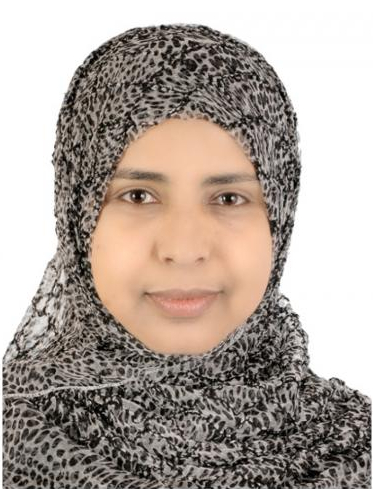
OWSD Award


About me
I am Dr. Ghanya Al-Naqeb, an Associate Professor of Nutritional Sciences (Nutrigenomics) and a national of Yemen. I hold a Ph.D. in Nutritional Sciences (Nutrigenomics) from Universiti Putra Malaysia (2009), an M.Sc. in Nutritional Biochemistry from the same university (2005), and a Bachelor's degree in Nutrition from the University of Damascus, Syria (1998). Currently, I serve as a senior scientist at the University of Pavia, Italy, in the Laboratory of Dietetics and Clinical Nutrition, Department of Public Health, Experimental and Forensic Medicine. A significant part of my work involves academic teaching for undergraduate and master's students, as well as supervising master’s theses in the fields of Nutrition and Food Sciences. My research focus on Biodiversity and Human Wellbeing, with a particular focus on bioprospecting and the bioactivity of plant-based resources. I specialize in the identification, characterization, and enhancement of plant-derived secondary bioactive metabolites, exploring their potential applications in the food, pharmaceutical, cosmetic, and biomaterial industries.
To date, my research has primarily focused on the preclinical investigation of herbal plants, nutrients, functional foods, and nutraceuticals in the prevention of chronic diseases—especially obesity, oxidative stress, type 2 diabetes, inflammation, and cancer. A key component of my work also involves assessing the toxicological and safety profiles of these natural compounds. I have extensive experience with a wide array of methodologies and technologies, including green extraction techniques, in vitro and in vivo models, molecular biology, toxicology, and protein expression analysis. My scientific expertise has been enriched through training and research collaborations in advanced laboratories across Malaysia, the USA, Germany, and Italy.
I am Dr. Ghanya Al-Naqeb, an Associate Professor of Nutritional Sciences (Nutrigenomics) and a national of Yemen. I hold a Ph.D. in Nutritional Sciences (Nutrigenomics) from Universiti Putra Malaysia (2009), an M.Sc. in Nutritional Biochemistry from the same university (2005), and a Bachelor's degree in Nutrition from the University of Damascus, Syria (1998). Currently, I serve as a senior scientist at the University of Pavia, Italy, in the Laboratory of Dietetics and Clinical Nutrition, Department of Public Health, Experimental and Forensic Medicine. A significant part of my work involves academic teaching for undergraduate and master's students, as well as supervising master’s theses in the fields of Nutrition and Food Sciences. My research focus on Biodiversity and Human Wellbeing, with a particular focus on bioprospecting and the bioactivity of plant-based resources. I specialize in the identification, characterization, and enhancement of plant-derived secondary bioactive metabolites, exploring their potential applications in the food, pharmaceutical, cosmetic, and biomaterial industries.
To date, my research has primarily focused on the preclinical investigation of herbal plants, nutrients, functional foods, and nutraceuticals in the prevention of chronic diseases—especially obesity, oxidative stress, type 2 diabetes, inflammation, and cancer. A key component of my work also involves assessing the toxicological and safety profiles of these natural compounds. I have extensive experience with a wide array of methodologies and technologies, including green extraction techniques, in vitro and in vivo models, molecular biology, toxicology, and protein expression analysis. My scientific expertise has been enriched through training and research collaborations in advanced laboratories across Malaysia, the USA, Germany, and Italy.
Degrees:
Patents
1. Ismail, M., Al-Naqeeb, G. (2011). Cardioprotective Effects of Nutraceuticals Isolated from Nigella Sativa Seeds. US Patent App. 13/124,370.
2. Ismail, M., Al-Naqeeb, G., Chan, W., Adnan, N.E. (2013). Extraction of Fixed Oil and Thymoquinone Rich Fraction. US Patent App. 13/832,499.
Peer-Reviewed Articles (Peer-Reviewed Journals)
3. Global Burden of Cardiovascular Diseases and Risks 2023 Collaborators (2025). Global, Regional, and National Burden of Cardiovascular Diseases and Risk Factors in 204 Countries and Territories, 1990-2023. Journal of the American College of Cardiology, S0735-1097(25)07428-5. https://doi.org/10.1016/j.jacc.2025.08.015.
4. Kalmpourtzidou, A., Boussetta, S., Maccarini, B., Al-Naqeb, G., De Giuseppe, R., D Addezio, L., Mistura, L., Cena. H. (2025). Higher dietary species richness is associated with better diet quality in adults: results from the Italian IV-SCAI survey. Accepted in Food Research International. Food Research International, 221, 117483.https://doi.org/10.1016/j.foodres.2025.117483.
5. Kalmpourtzidou, A., Boussetta, S., Al-Naqeb, G., De Giuseppe, R., & Cena, H. (2025). Novel foods, neglected and alien species to increase food biodiversity of diets in Europe. Future Foods, 11, 100596. DOI: 10.1016/j.fufo.2025.100596
6. Al-Naqeb, G., Pietrolucci, F., Commisso, M., Kalmpourtzidou, A. et al. (2025). Metabolomic profiling and in vitro evaluation of cytotoxic, genotoxic, and antigenotoxic effects of Staphylea pinnata L. extract from Italian flora. Biomolecules, 15, 385. DOI: 10.3390/biom15030385
7. Al-Naqeb, G., Zorzi, G., Oldani, A., et al. (2024). Phytochemical profile and in vitro cytotoxic, genotoxic, and antigenotoxic evaluation of Cistus monspeliensis L. leaf extract. International Journal of Molecular Sciences, 25, 13707. DOI: 10.3390/ijms252413707
8. Al-Naqeb, G., Kalmpourtzidou, A., Giampieri, F., De Giuseppe, R., & Cena, H. (2024). Genotoxic and antigenotoxic medicinal plant extracts and their main phytochemicals: A review. Frontiers in Pharmacology, 15, 1448731. DOI: 10.3389/fphar.2024.1448731
9. Kalmpourtzidou, A., De Giuseppe, R., Vincenti, A., Al-Naqeb, G., & Cena, H. (2023). The effect of nature-based solutions on human nutrition and food security in urban settings. Proceedings, 91, 214. DOI: 10.3390/proceedings202309121
10. Al-Naqeb, G., Kalmpourtzidou, A., De Giuseppe, R., & Cena, H. (2023). Beneficial effects of plant oils supplementation on multiple sclerosis: A comprehensive review of clinical and experimental studies. Nutrients, 15, 4827. DOI: 10.3390/nu15224827
11. Al-Naqeb, G., Cafarella, C., Aprea, E., et al. (2023). Supercritical fluid extraction of oils from cactus Opuntia ficus-indica L. and Opuntia dillenii seeds. Foods, 12, 618. DOI: 10.3390/foods12030618.
12. Al-Naqeb, G., Sidarovich, V., Scrinzi, D., et al. (2022). Hydrochar and hydrochar co-compost from OFMSW digestate for soil application: 3. Toxicological evaluation. Journal of Environmental Management, 320, 115910. DOI: 10.1016/j.jenvman.2022.115910
13. Al-Naqeb, G., Fiori, L., Ciolli, M., & Aprea, E.et al. (2021). Prickly pear seed oil extraction, chemical characterization and potential health benefits. Molecules, 26, 5018.DOI: 10.3390/molecules26165018
14. Al-Naqeb, G. (2020). Antioxidant activity and cholesterol regulation effect of Caralluma flava N.E.Br extract in HepG2 cells. Arabian Journal of Medicinal and Aromatic Plants, 6(3), 57–75.DOI: 10.48347/IMIST.PRSM/ajmap-v6i3.23655
15. Kaokabah, N., Al-Qubati, A., & Al-Naqeb, G. (2020). Anti-obesity effects of Pulicaria jaubertii E. Gamal-Eldin in high-fat diet-induced rats. Universal Journal of Pharmaceutical Research, 5(5).DOI: 10.22270/ujpr.v5i5.487
16. Al-Naqeb, G. (2017). Acute toxicity and anti-ulcerative potential of Caralluma flava N.E.Br methanolic extract against ethanol-induced gastric ulcers in rats. Journal of Medicinal Plants Studies, 5(6), 21–25.
17. Al-Naqeb, G. (2017). Caralluma flava N.E.Br extract reduces plasma glucose level and improves plasma antioxidant enzymes in hyperglycemic rats. Journal of Medicinal Plants Studies, 5(6), 39–43.
18. Al-Naqeb, G., & Taj Al-Deen, A. (2017). The effect of Rumex nervosus Vahl leaves on high-fat diet-induced hyperglycemia and hyperlipidemia in albino rats. International Journal of Chemical Science, 1(2), 80–83.
19. Al-Naqeb, G., Rousová, J., Kubátová, A., & Picklo, M. J. Sr. (2016). Pulicaria jaubertii E. Gamal-Eldin reduces triacylglyceride content and modifies cellular antioxidant pathways in 3T3-L1 adipocytes. Chemico-Biological Interactions, 253, 48–59.DOI: 10.1016/j.cbi.2016.05.013
20. Al-Naqeb, G. (2015). Effect of prickly pear cactus seed oil on the blood glucose level of streptozotocin-induced diabetic rats and its molecular mechanisms. International Journal of Herbal Medicine, 3(4), 29–34.
21. Al-Naqeb, G. (2015). Antioxidant and antibacterial activities of some Yemeni medicinal plants. International Journal of Herbal Medicine, 3(3), 6–11.
22. Mohd Ghazali, M. A., Al-Naqeb, G., et al., (2014). Apoptosis induction by Polygonum minus is related to antioxidant capacity, alterations in expression of apoptotic-related genes, and S-phase cell cycle arrest in HepG2 cells. BioMed Research International, 2014, 539607. DOI: 10.1155/2014/539607
23. Wesam, R. K., Ghanya, A. N., et al. (2013). Assessment of genotoxicity and cytotoxicity of standardized aqueous extract from leaves of Erythroxylum cuneatum in human HepG2 and WRL68 cells line. Asian Pacific Journal of Tropical Medicine, 6(10), 811–816. DOI: 10.1016/S1995-7645(13)60143-1
24. Taj Al-Deen, A., Al-Naqeb, G., & Al-Maqtari, Q. (2013). Potential antioxidants and antibacterial from Dodonaea viscosa, Fragaria x ananassa Duch and Vernonia amygdalina leaves. University of Aden Journal of Natural and Applied Sciences, 17, 2013.
25. Azahar, M. A., Al-Naqeb, G., et al. (2012). Hypoglycemic effect of Octomeles sumatrana aqueous extract in streptozotocin-induced diabetic rats and its molecular mechanisms. Asian Pacific Journal of Tropical Medicine, 5(11), 875–881. DOI: 10.1016/S1995-7645(12)60163-1
26. John, C. M., Ramasamy, R., Al Naqeeb, G., Al-Nuaimi, A. H. D., & Adam, A. (2012). Enhanced CD4+CD25+ regulatory T cells with splenic proliferation and protection against oxidative stress by nicotinamide in gestational diabetes. Current Medicinal Chemistry. Advance online publication. DOI 10.2174/092986712803530449
27. John, C. M., Ramasamy, R., Al Naqeeb, G., et al., (2012). Nicotinamide supplementation protects gestational diabetic rats by reducing oxidative stress and enhancing immune responses. Current Medicinal Chemistry, 19(30), 5181–5186. DOI: 10.2174/092986712803530449
28. Al-Naqeep, G., Al-Zubairi, A. S., Ismail, M., et al., (2011). Antiatherogenic potential of Nigella sativa seeds and oil in diet-induced hypercholesterolemia in rabbits. Evidence-Based Complementary and Alternative Medicine: eCAM, 2011, 213628. DOI: 10.1093/ecam/neq071
29. Ismail, N., Ismail, M., Al-Absi, A., & Al-Naqeeb, G. (2011). Thymoquinone-rich fraction from Nigella sativa and thymoquinone are cytotoxic towards colon and leukemic carcinoma cell lines. Journal of Medicinal Plants Research, 5(15), 3359–3366.
30. Al-Naqeb, G., Ismail, M., Bagalkotkar, G., & Adamu, H. (2010). Vanillin-rich fraction regulates LDLR and HMGCR gene expression in HepG2 cells. Food Research International, 43, 2437–2443. DOI: 10.1016/j.foodres.2010.09.015
31. Ismail, M., Al-Naqeeb, G., & Chan, K. W. (2010). Nigella sativa thymoquinone-rich fraction greatly improves plasma antioxidant capacity and expression of antioxidant genes in hypercholesterolemic rats. DOI: 10.1016/j.freeradbiomed.2009.12.002
32. Mariod, A. A., Al-Naqeep, G., & Ismail, M. (2010). Monechma ciliatum methanolic extract regulates low density lipoprotein receptor and 3-hydroxy-3-methylglutaryl coenzyme A reductase genes expression in HepG2 cells. DOI:
33. Ismail, M., Al-Naqeeb, G., Mamat, W. A., & Ahmad, Z. (2010). Gamma-oryzanol rich fraction regulates the expression of antioxidant and oxidative stress related genes in stressed rat's liver. DOI: 10.1186/1743-7075-7-23
34. Al-Naqeep, G., Ismail, M., & Allaudin, Z. (2009). Regulation of low-density lipoprotein receptor and 3-hydroxy-3-methylglutaryl coenzyme A reductase gene expression by thymoquinone-rich fraction and thymoquinone in HepG2 cells. DOI: 10.1159/000227264
35. Al-Naqeep, G., & Ismail, M. (2009). Effects of thymoquinone rich fraction and thymoquinone on plasma lipoprotein level and hepatic low-density lipoprotein receptor and 3-hydroxy-3-methylglutaryl coenzyme A reductase gene expression. DOI: 10.1016/j.jff.2009.06.003
36. Al-Naqeep, G. N., Ismail, M. M., Al-Zubairi, A. S., & Esa, N. M. (2009). Nutrients composition and minerals content of three different samples of Nigella sativa L. cultivated in Yemen.
37. Al-Naqeep, G., & Ismail, M. (2009). Regulation of Apolipoprotein A-1 and Apolipoprotein B100 genes by thymoquinone rich fraction and thymoquinone in HepG2 cells.
38. Al-Naqeeb, G., Ismail, M., & Al-Zubairi, A. S. (2009). Fatty acid profile, α-tocopherol content and total antioxidant activity of oil extracted from Nigella sativa seeds.
39. Yazan, L. S., Ng, W. K., Al-Naqeeb, G., & Ismail, M. (2009). Cytotoxicity of thymoquinone (TQ) from Nigella sativa towards human cervical carcinoma cells (HeLa).
C- (Conference paper)
40. Aliki Kalmpourtzidou1, Beatrice Maccarini1, Ghanya Al-Naqeb, Rachele de Giuseppe 1, Hellas Cena. The effect of urban gardening/farming on human nutrition and wellbeing: a systematic review. Belgrade, Serbia. 14-17th November 2023.
41. Al-Naqeb, G. (2022). Genotoxicity Evaluation of Prickly Pear Cactus Seeds Oil in Cultured V79 Cells. September 2022. DOI: 10.21748/ZIFS8532. Conference: 2022 AOCS Annual Meeting & Expo.
42. Ghanya Al-Naqeb, Harald L. Esch, Carolin Kleider, Matthew J. Picklo Sr, Leane Lehmann, Antiadipogenic properties, Chemical characterization and Genotoxicity Approaches of Pulicaria Jaubertii E. Gamal-Eldin leaves Extract Originated from Yemen, 19th International Congress of the International Society for Ethnopharmacology (12th- 14th June 2019) “ Hörsaalzentrum of the Technische Universität Dresden. 12th-14th June 2019.
43. Picklo M, Rousova J, Kubatova, Al-Neqeb G. (2015). Pulicaria jaubertii Extract Prevents Triglyceride Deposition in 3T3-L1 Adipocytes. FASEB J, 29(1):924.19.
44. Kraidi, S., Adam, A., Iryani, W., Al-Naqeb, G. (2013). Antiproliferative Effect of Antioxidant Rich Fraction Isolated from Cassia Auriculat and its Molecular Mechanisms. The Open Conference Proceedings Journal, 2013, Volume 4. 10.2174/2210289201304010228.
